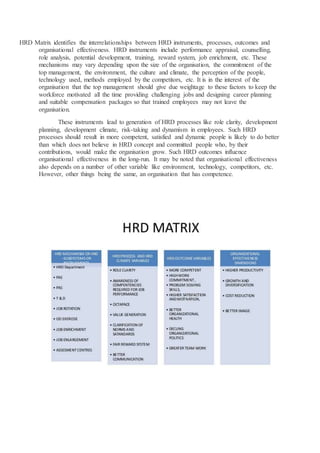Hrd matrix
- 1. HRD Matrix identifies the interrelationships between HRD instruments, processes, outcomes and organisational effectiveness. HRD instruments include performance appraisal, counselling, role analysis, potential development, training, reward system, job enrichment, etc. These mechanisms may vary depending upon the size of the organisation, the commitment of the top management, the environment, the culture and climate, the perception of the people, technology used, methods employed by the competitors, etc. It is in the interest of the organisation that the top management should give due weightage to these factors to keep the workforce motivated all the time providing challenging jobs and designing career planning and suitable compensation packages so that trained employees may not leave the organisation. These instruments lead to generation of HRD processes like role clarity, development planning, development climate, risk-taking and dynamism in employees. Such HRD processes should result in more competent, satisfied and dynamic people is likely to do better than which does not believe in HRD concept and committed people who, by their contributions, would make the organisation grow. Such HRD outcomes influence organisational effectiveness in the long-run. It may be noted that organisational effectiveness also depends on a number of other variable like environment, technology, competitors, etc. However, other things being the same, an organisation that has competence.
- 2. Whatis GreenHR? The term ‘green HR’ is most often used to refer to the contribution of people management policies and practices towards the broader corporate environmental agenda. Typical greenactivities include video recruiting, or the use of online and video interviews, to minimize travel requirements. Green rewards can include the use of workplace and lifestyle benefits, ranging from carboncreditoffsets to free bicycles, to engage people in the green agenda, while continuing to recognize their contribution. While many employees often feel it is not their responsibility to protect theenvironment while they are at work, the new workforce of millenials are emphasizingenvironmental consciousness as they chose their employers. There is also a broader opportunity to engage the workforce given that more and more people seek meaning and self-actualization in their jobs. Other simple green actions include minimizing the amount of printed materials used in performance management, salary reviews and so on. While there is definitely a substantial amount of ‘green washing’ occurring in reducing waste, there are many opportunities here too. However, HR is never going to have a truly significant impact on a business through the improvement of HR processes alone so the greater opportunity is to contribute to the green agenda of the business as a whole.

